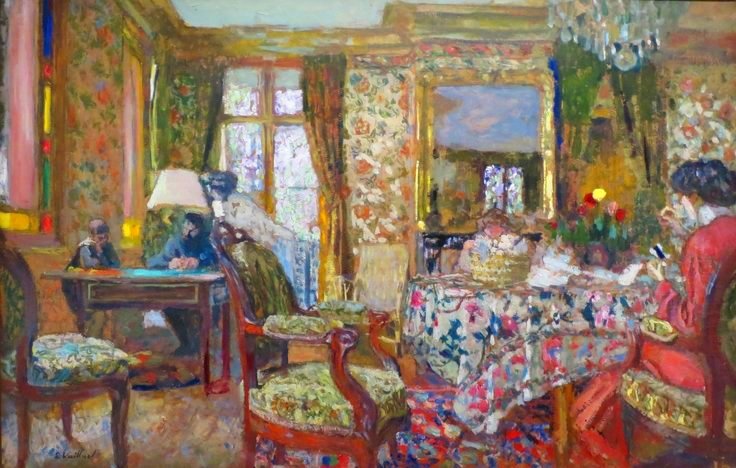French Masters from the Pushkin
 |
| Vuillard's Interior, 1904 |
Getting High on a New Supply
It’s no secret what the Japanese art public really like – soft, flowery Impressionism and cute, colorful post-Impressionism, with, possibly, a smattering of Picassos and Matisses thrown in to add grit. Hold a show with this kind of art and you’ll have to hang the paintings high, as they reportedly did earlier this year at the National Museum of Modern Art’s major Van Gogh exhibition, so that people could see them more easily in the crowd.
Unfortunately, such paintings are in demand all over the world, and, since September 11 led to a spike in insurance and other costs, really satisfying exhibitions of this ilk have been hard to come by. Even the exhibition at the National Museum of Modern Art had to make do with less than 30 oils by Van Gogh, and many of those lesser works.
Imagine, then, what a shot in the arm “Masterworks of French Impressionism and Modernism from the Pushkin Museum” must be.
With 75 works (including about 50 oils) by artists such as Degas, Monet, Pissarro, Renoir, Sisley, Cezanne, Van Gogh, Rousseau, Bonnard, Signac, Matisse, Derain, Gauguin, Vlaminck, Braque, and Picasso, this is an exhibition that gives the public what they really want.
 |
| In the Garden or Under the Trees of the Moulin de la Galette, 1876 |
If Impressionism and Early Modernism is the Japanese art public’s drug of choice, clearly there is a new high quality supplier in town, temporarily flooding the market, and getting people high. Traditionally Japanese museums have relied on a ‘French connection’ or other Western European or American sources for this kind of art. But with these supplies now disrupted, Japanese curators and project planners, like Daisuke Kusakari who worked on this exhibition for the Asahi Shimbun’s Cultural Projects Department, have been forced to look further afield, in this case, blazing a trail to Moscow’s still relatively neglected Pushkin Museum
"It’s very hard to work over there," Kusakari says of his visits to the Russian capital to arrange loans. "It’s not convenient, because, unlike dealing with Western institutions, where there is a common way of doing things, they haven’t quite got used to dealing with us yet. Sometimes, even after ordering a painting beforehand, we have to check later if it is still available."
No doubt such difficulties are a hangover from the bad old days of Soviet rule, when red tape and suspicion of foreigners were as hard to surmount as the Berlin Wall. Indeed, it even seems strange that such a collection as this ever passed through the hands of the inhuman Soviet system that claimed to loathe all things bourgeois, as these paintings are the perfect expression of the markedly un-Communistic tastes of the original collectors, Sergei Shchukin (1854–1936) and Ivan Morozov (1871–1921), two Moscow merchants engaged in the textile industry, whose separate private collections were confiscated and opened to the public following the Russian Revolution.
 |
| Her Name was Vairaumati (1892) |
In the Japanese context, these works have the effect of confirming and strengthening the dominant taste for what is, after all, a narrow band of Western art. Due to the problems Japanese museums faced acquiring such art, they had been willing to experiment and present a greater range of Western art to the public. For example, earlier this year, the Yokohama Museum of Art featured “Masterpieces from the Louvre Museum,” an exhibition that focused entirely on paintings that predated the Japanese public’s favorite period. Likewise, the National Museum of Western Art cast its spotlight on the under–appreciated French baroque painter, Georges de La Tour. It’s hard to believe that either museum would have explored these avenues of art if there had been a ready supply of good Monets, Renoirs, and Matisses knocking about.
So, doesn’t an exhibition like this serve to limit the Japanese public to art it already adores rather than expose it to something less familiar? While agreeing in part, Kusanari believes that the main priority for Japanese museums is to build up their audience by giving people what they want.
"In my opinion, the Japanese public is not really used to going to museums,” he says. “Every museum is suffering from financial cuts, so we have to build up an audience that frequently visits museums. I believe this show will influence people positively, and bring lots of first time visitors to the museum."
With an exhibition of this quality, this may well be true, but it should be remembered that first impressions count for more, and in this case could prove habit forming. Giving the public a glut of such delicious art runs the risk of ruining their appetites for anything less accessible and immediately gratifying.
C.B.Liddell
Japan Times
3rd November, 2005




















Post A Comment
No comments :